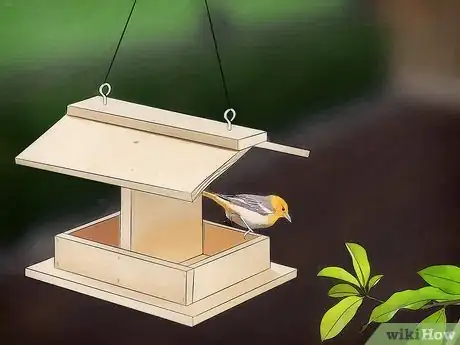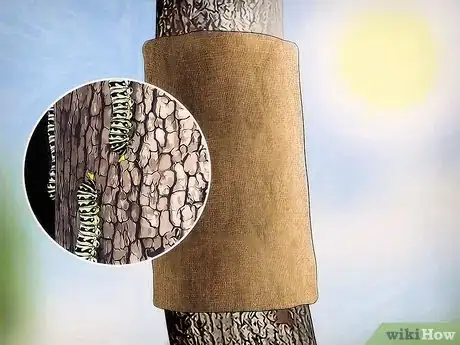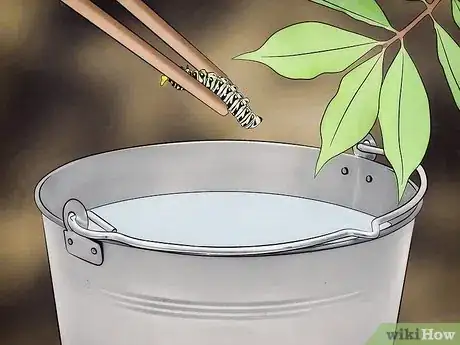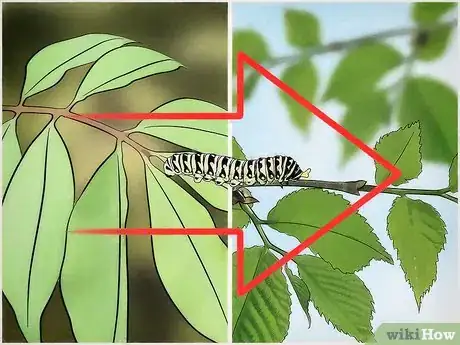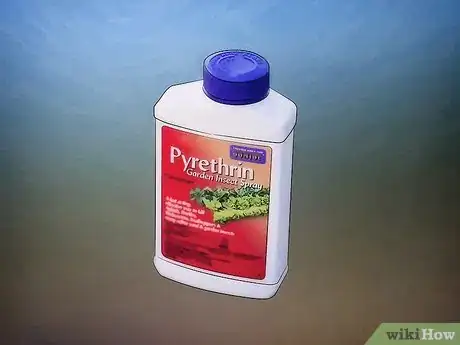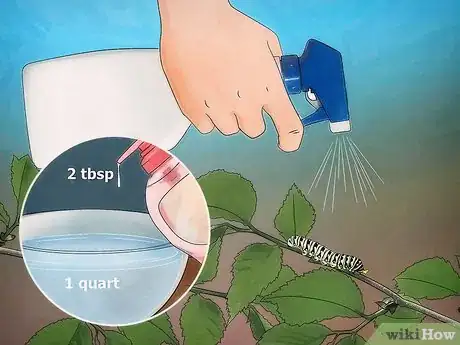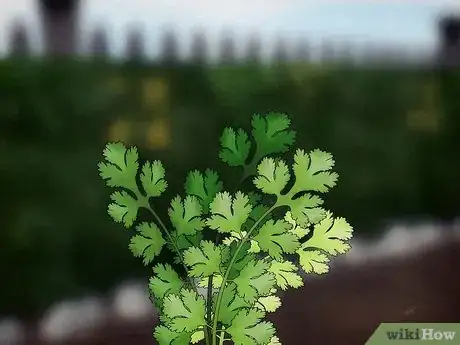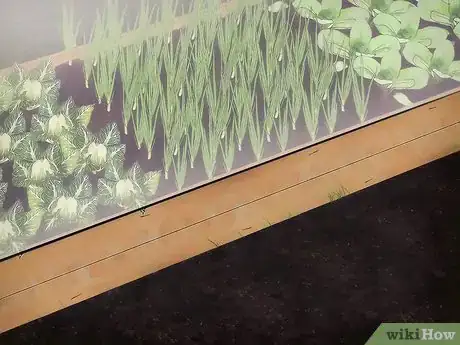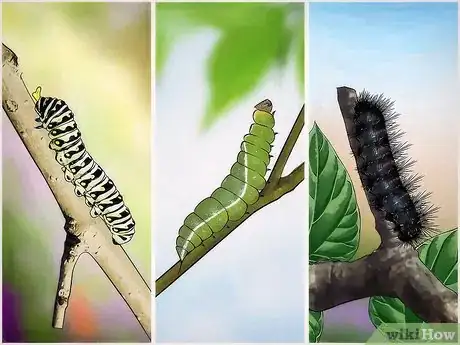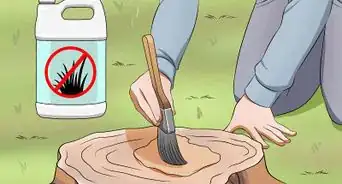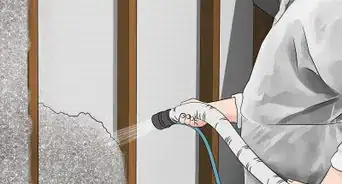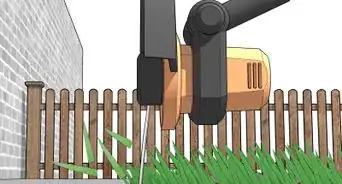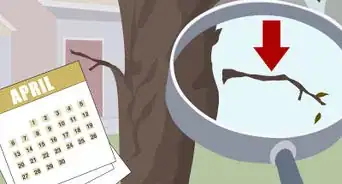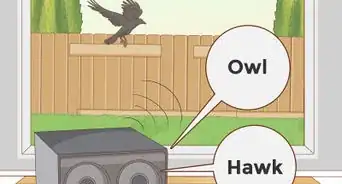This article was co-authored by Lauren Kurtz. Lauren Kurtz is a Naturalist and Horticultural Specialist. Lauren has worked for Aurora, Colorado managing the Water-Wise Garden at Aurora Municipal Center for the Water Conservation Department. She earned a BA in Environmental and Sustainability Studies from Western Michigan University in 2014.
There are 11 references cited in this article, which can be found at the bottom of the page.
wikiHow marks an article as reader-approved once it receives enough positive feedback. In this case, several readers have written to tell us that this article was helpful to them, earning it our reader-approved status.
This article has been viewed 251,645 times.
Caterpillars are the larval form of butterflies and moths and are easily identified by their worm-like, soft bodies. They can come in many sizes and colors, but all of them can be very destructive to plants and trees. Knowing what you are dealing with can make getting rid of them easier. They typically appear most heavily in the fall, but they can be found at other times of the year when the weather is warm. If you are struggling to get rid of caterpillars, try out a few natural remedies. If that doesn’t work, you can try some soap insecticides or other remedies for getting rid of caterpillars.
Steps
Using Natural Remedies
-
1Try using Bacillus thuringiensis var kurstaki (BTk). BTk is a bacteria that naturally occurs on dead or decaying material in the soil. This bacteria is good for controlling caterpillars because it interacts badly with the digestive system of caterpillars. Furthermore, it is considered to be safe because it doesn’t harm pets or people, and the dead caterpillars will not harm other animals (such as birds) that might eat the caterpillar.[1]
- It is important that you apply BTk to leaves of affected plants or trees at the right time because it must be eaten by the caterpillar. You should follow the instructions that come with the BTk, but generally, it should be applied twice. The first time will be about ten days after caterpillar eggs have hatched, and the second time about two weeks later, while the caterpillars are still small.
- BTk is available commercially, so you can probably get it at your local home improvement or gardening store. It is usually sold in powder form, which is then mixed with water and sprayed onto infested plants.
-
2Make the area attractive to birds. Birds are perhaps the best at controlling caterpillars naturally. Thus, it is a good idea to make your garden appealing to them. Try placing a birdbath, some bird feeders, and even a bird house or two into the garden to elicit interest.[2]
- If you have cats that go into the yard, make sure that they wear a collar with a bell on it. This alerts birds when a cat is in the area.
- If you have space, chickens also offer a great way to get rid of caterpillars. Chickens will eat the caterpillars, so you won’t have to worry about dealing with them yourself.[3] However, you will need to prepare your yard properly to keep chickens healthy and safe, so this shouldn’t be seen as a quick and easy fix.
Advertisement -
3Use burlap to catch caterpillars living in a tree. If you are having a problem with caterpillars in a tree, you can wrap the trunk with burlap. Caterpillars like to hide during the heat of the day, and the burlap offers an ideal place to get out of the sun. Once they’ve crawled in, you can smash many caterpillars quickly.[4]
- This may work especially well for spongy moth caterpillars, which tend to live in trees.
-
4Drown the caterpillars. If you aren’t afraid of touching the caterpillars, then this is one way to get rid of caterpillars without spraying chemicals or other substances on your leaves.[5]
- Fill a bucket about halfway with water. The size of the bucket depends on how many caterpillars you are dealing with. If it is just a few, a coffee can might do. If you have a lot of caterpillars, you might need a 5-gallon pail.
- Add dish soap. If you are using a relatively small-sized bucket, a quarter of a cup should do. Add more if you are using a large bucket. This is not an exact science, so don’t worry about getting the measurements exactly right.
- Pick the caterpillars up and throw them in the water, where they will die. Wear gloves if you want to.
-
5Collect the caterpillars and move them elsewhere. Caterpillars eventually turn into moths and butterflies, which play an important role in pollination.[6] Thus, you might want to consider moving the caterpillars elsewhere (e.g. a nearby wooded area) where they can live without harming your plants.
- You can do this by collecting the caterpillars in a bucket or a jar. Take them to the area you want them, and then gently dump them onto a leaf or tree branch.
Using Soap, Pesticides, and Other Remedies
-
1Try pyrethrins. Pyrethrins are a natural pesticide that is made from plants, specifically chrysanthemums. They are toxic to many pests, including caterpillars. Generally, it is safe for humans and pets, but it could be toxic if ingested in huge amounts. These are typically sold in garden and home improvement stores. The product is typically sprayed directly on infested plants, and is degraded within a few days by sunlight.[7]
- If you go shopping for pyrethrin pesticides, you will likely come across products that contain “pyrethroids,” these are simply synthetically produced versions of pyrethrum.
- You can protect beneficial insects from being harmed by this product by applying it to the affected plants early in the morning, and then cover the plant with an old sheet for 24 hours.[8]
-
2Make an insecticidal soap spray. This type of spray should be applied directly to the caterpillars. It works because the soap destroys the skin of the caterpillar. In order to make this spray, simply mix two tablespoons of soap into one quart of water into a spray bottle. Shake the mixture well, and then spray it directly on any caterpillars you find.[9]
- Make sure the soap is biodegradable and plant based in order to avoid harming plants, animals, and bugs that don’t harm your plants.
-
3Purchase a commercial garden pesticide. This should be considered a last resort given the harmful effects pesticides can have on beneficial insects and the environment, but if you must use a pesticide, make sure that it is designed to work against caterpillars. You can find all of this information on the label.[10]
- Remember that if you have pets or small children, using a pesticide may harm them if they come in contact with the pesticide.
- It is not a good idea to use pesticides in gardens where there are plants that will be eaten.
Controlling Caterpillars in Your Garden
-
1Add some plants that attract beneficial insects to your garden. Planting flowers such as aster and yarrow, or cilantro, fennel, or dill may attract beneficial insects (insects that eat other insects), which eat caterpillars. Be sure to have these plants growing throughout the season to keep the beneficial insects coming.[11]
- Planting these types of plants provides a source of alternative food for the beneficial insects, and will keep them coming back even after they’ve taken care of any caterpillars.
-
2Use an insect barrier. An insect barrier is a type of fabric that you can use to cover your plants. This barrier will prevent moths and butterflies from laying eggs on your plants, which then hatch to become caterpillars.
- This may be ideal for plants that grow fall vegetables. In this case, pollination does not play a huge role so covering the plants will not reduce the amount of vegetables grown by the plant.
-
3Identify caterpillars. Caterpillars come in many different shapes and sizes. Some are large, some are small, some are hairy, and some look like worms. If you haven’t seen any caterpillars, but notice that the leaves of your plants are covered in holes, then you likely have caterpillars in your garden.[12]
- Almost all caterpillars can be taken care of using one of the above-mentioned methods. However, tent caterpillars, which usually live in trees. These caterpillars usually live in webs. These types of caterpillars can be controlled in the same way, but you can also try to remove the branches of the tree where the nest is, and then burn the web nest.
- Although caterpillars are generally harmless to humans and cannot bite, there are several species of caterpillars that can give a painful sting. There are many different types of stinging caterpillars that all look very different; therefore, you should generally assume that if a caterpillar has a furry appearance or barbs that it will sting you if you touch it. The sting may not be fatal, but it will be very painful, so it’s best to avoid touching a caterpillar if you aren’t sure what kind it is.[13]
Expert Q&A
Did you know you can get expert answers for this article?
Unlock expert answers by supporting wikiHow
-
QuestionWhat can I do about an invasion of the Forest Tent caterpillar?
 Lauren KurtzLauren Kurtz is a Naturalist and Horticultural Specialist. Lauren has worked for Aurora, Colorado managing the Water-Wise Garden at Aurora Municipal Center for the Water Conservation Department. She earned a BA in Environmental and Sustainability Studies from Western Michigan University in 2014.
Lauren KurtzLauren Kurtz is a Naturalist and Horticultural Specialist. Lauren has worked for Aurora, Colorado managing the Water-Wise Garden at Aurora Municipal Center for the Water Conservation Department. She earned a BA in Environmental and Sustainability Studies from Western Michigan University in 2014.
Professional Gardener
-
QuestionHow do I get rid of dead caterpillars without touching them?
 Community AnswerSweep them into a dustpan with a broom, pick them up with a paper towel, or ask someone else to remove them for you.
Community AnswerSweep them into a dustpan with a broom, pick them up with a paper towel, or ask someone else to remove them for you. -
QuestionWhat's the best way to prevent damage to my plants when getting rid of caterpillars?
 Community AnswerYou can use the soap-bucket-drowning method mentioned above. It will not hurt plants or animals as long as you don’t pour the solution everywhere.
Community AnswerYou can use the soap-bucket-drowning method mentioned above. It will not hurt plants or animals as long as you don’t pour the solution everywhere.
Warnings
- Don’t touch a caterpillar that is furry or spiny looking, as these may sting you.⧼thumbs_response⧽
References
- ↑ https://extension.entm.purdue.edu/GM/PDF/GMquestions.pdf
- ↑ http://www.getridofthings.com/pests/bugs/get-rid-of-caterpillars/
- ↑ http://www.motherearthnews.com/homesteading-and-livestock/pestpatrol-zl0z0703zswa.aspx
- ↑ http://www.getridofthings.com/pests/bugs/get-rid-of-caterpillars/
- ↑ http://www.getridofthings.com/pests/bugs/get-rid-of-caterpillars/
- ↑ http://www.fs.fed.us/wildflowers/pollinators/animals/moths.shtml
- ↑ http://www.todayshomeowner.com/is-pyrethrum-a-safe-organic-pesticide/
- ↑ http://www.motherearthnews.com/organic-gardening/pest-control/make-organic-pyrethrum-spray-zw0z1304zkin.aspx
- ↑ http://www.sparkpeople.com/resource/nutrition_articles.asp?id=1324&page=2
- ↑ http://ipm.ucanr.edu/PMG/PESTNOTES/pn74126.html
- ↑ http://www.motherearthnews.com/organic-gardening/natural-pest-control-beneficial-insects-zm0z12amzhir.aspx?PageId=2#ArticleContent
- ↑ http://www.getridofthings.com/pests/bugs/get-rid-of-caterpillars/
- ↑ http://www.arkinspace.com/2011/05/stinging-caterpillars-of-united-states.html
- ↑ http://animals.mom.me/predators-eat-caterpillars-6543.html
About This Article
To get rid of caterpillars in your garden, regularly pluck them off of plants and drop them into a bucket of soapy water. Make sure you wear gardening gloves since some caterpillars can sting. You can also spray or dust your plants with Bacillus thuringiensis, a bacteria that kills caterpillars when they ingest it. Bacillus thuringiensis is safe for plants, pollinators, and pets. Neem oil and pyrethrum are both also organic insecticides that will kill any munching caterpillars on your plants. Attracting natural caterpillar predators, like birds, toads, and lizards, to your yard can help too. Set up a bird feeder and bath in your garden, and provide shelter for potential predators by setting out logs or broken clay pots. Finally, try planting strong-smelling herbs like sage, lavender, and peppermint since they can also help keep caterpillars out of your garden. To learn how to use pesticides to get rid of caterpillars, scroll down!

